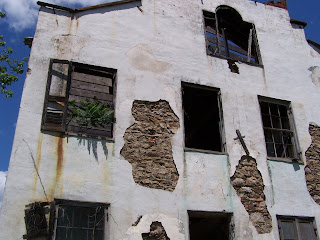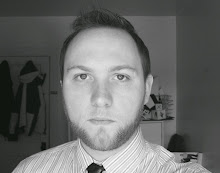This video is part seven in a series of videos I have up on my Design and Art channel on YouTube. To see other videos, click here.
So, just like I said in the video, this is a house just outside Danville, PA. I was with a friend back in 2007 and we came across this house on the way to Knoebels Amusement Resort. I just wanted to take this opportunity to talk more about this project since I didn't want to take up too much time in the video. Most people who watch YouTube have short attention spans, you know. One thing I wanted to correct about what I said in the video is that I said it took about 100 or more hours to complete the project, when in fact it took 100 or more hours for each piece. I kind of explained what I did in the video and tried to simplify what I was doing for people who don't know anything about the programs I used (Photoshop and Illustrator).
Photoshop is a pixel based program (you know, those little tiny squares) used to do many things to photographs. It can be used to restore old photos, touch up photos, to add or subtract objects in photos, to manipulate photos, etc. Some people get a little too trigger happy with filters which are one of the most overused features in Photoshop and unfortunately people too often abuse these filters. You can use filters to make a photo look like a pencil sketch, look like something is wrapped in plastic wrap, or one of my least favorites, lens flare. Lens flare isn't in itself a bad thing, it just gets overused way too much and usually in the wrong way. So, anyway I used a filter called posterize in Photoshop. You can make many adjustments within the posterize filter. I used very little posterization so that the pictures of the house would still be photorealistic. Here's an example of a picture that has been posterized at different levels:
This is a normal photo of my daughter, Chloe.
This is a slightly posterized photo. It still looks photographic, but look at the shades of grey on the wall in the background. This is what I meant in the video by making shapes come out in the pictures. this is probably the level of detail I worked at when I recreated the photos in Illustrator.
These last two are just an example of higher levels of posterization to show how it can really break a photo down into less colors and more basic shapes.
So that's pretty much all I did to the photos in Photoshop. The next thing I did was bring the photo into Illustrator. Illustrator is a vector based program which deals with points and lines rather than pixels. The good thing about vector images is they can be stretched to any size without losing any detail, unlike pixel based images which can become distorted when enlarged too much. So, I could actually enlarge the abandoned house images that I created in Illustrator to the actual size of a house and it would not lose any detail. If I only had some money and a space big enough to display that! Anyway, a little more about Illustrator. Rather than Photoshop which is used to alter images that already exist, Illustrator is mostly used to create images from scratch, such as logos.
What I did to the photographs in Illustrator is I made a layer over top of the photo, kind of like an invisible piece of tracing paper. I zoomed in at about 600% (which is what the close-ups in the video were zoomed in to) to really get a good look at the tiny shapes that appeared when I posterized the photos in Photoshop. You know, I don't even know if posterized is a real word, I keep getting a little red dotted line every time I type it. Oh well, I'm gonna keep using the term anyway. I guess the term they actually use in Photoshop is "Poster Edges", but I like posterize. Sorry, went a little off topic. After zooming in at about 600% I used the pen tool to trace around the little shapes and after doing that I would use the eyedropper tool. The eyedropper tool can be used to sample color from one object and make another object that same color. So I used it to sample color from the posterized image and made the shape I just created the same color.
I'd like to know just how many thousands and thousands, possibly tens of thousands of times I did this. It was very tedious work, but I had a great time doing it. Working on a project for this amount of time really gets you close to the subject. I really wanted to know what the story was behind this house. What happened? Who lived there? The house had obviously been on fire, did everyone make it out safely? I've tried looking it up online, but have found nothing. Just in case any of you were wondering, the interior shots were taken outside of the house through the windows. We did not put ourselves in any danger by going inside. In one of the pictures you can clearly see there is a big hole in the floor.
Why would I want to do a series on an abandoned, burned out, broken down old house? Because it's much more interesting than a perfect, white picket fence, dream house. Think about it, what would keep your attention longer. A perfect house with no blemishes or a broken house with so much detail and character? I think as humans we can relate to this house. No one is perfect and in some way we are all broken. Perhaps we are drawn to the abandoned house because we can relate to it. This past summer, I visited the abandoned house again on the way to Knoebels. I was with my wife, my dad, and my daughter. It was kind of surreal being there. All that time I spent working on this project and then returning to see it in person six years later. It was like seeing an old friend. It was different though, it was almost completely covered in ivy. The house probably thought the same about me. Not that I was covered in ivy, but that I looked different.
I'd like to hear what you think. Comment below, or if you found your way here because of Facebook or YouTube, you can comment or ask me questions on those sites as well.
I also want to thank my good friend Jeramy Mohler for letting me use his song "On Fire" for this video. Jeramy along with my other good friends Jesse and Natalie Turri, Matt Barlow, and Jerome (I can't remember his last name) were in a great band called Plural Form. The other two songs during the commentary were "Copper Island" by Unwed Sailor and "Rage:Man" by Mogwai.
As a bonus, I'll include all of the pictures from the video below. Click on them to enlarge them.
Original Photos
Framework
Shadows
Negatives
Finished Illustrator Images
Original Photograph and Finished Illustrator Image comparison
Close-ups

































































